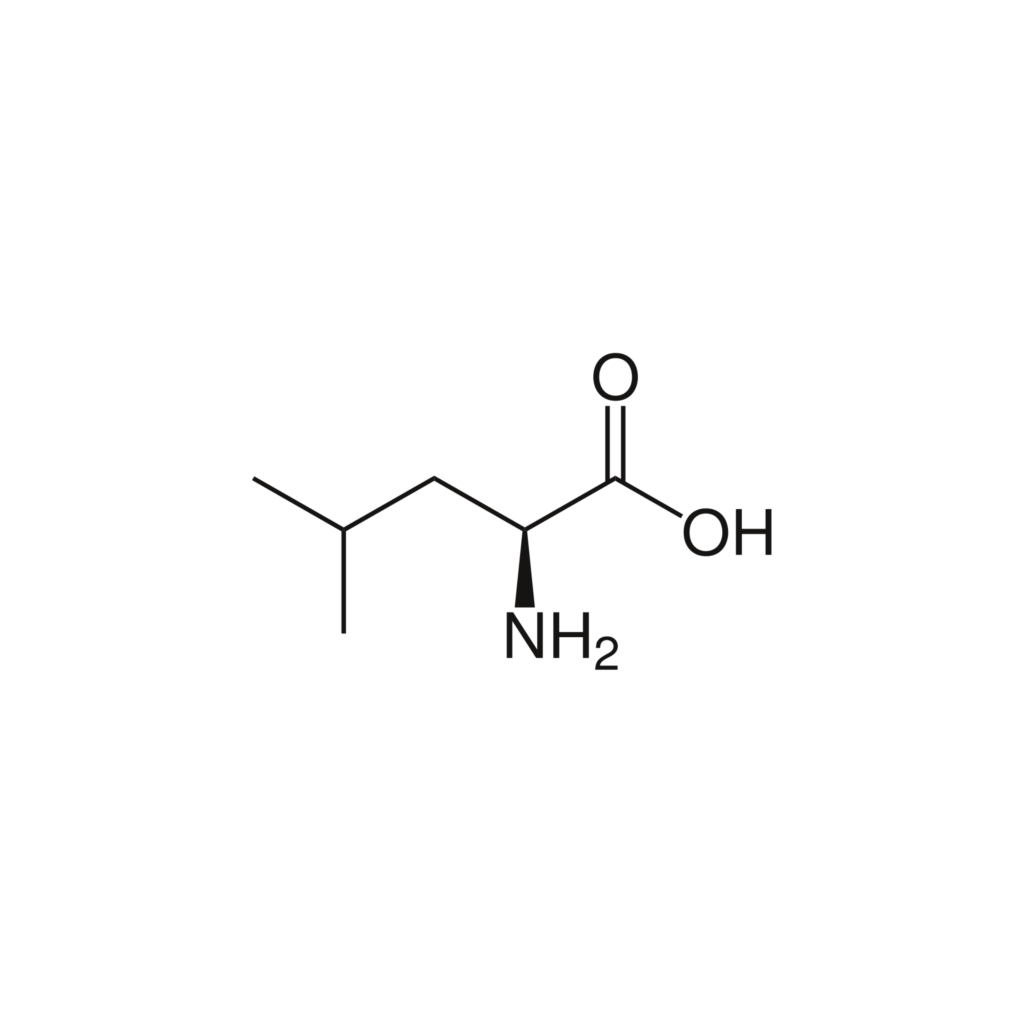No products in the cart.
The Vital Science Blog
Starting Living Your Best
- Premium Fitness Updates
- Exclusive Discounts
Leucine and its Metabolites

Leucine and its Metabolites
Amino acids are the major constituents of proteins and are generally described as the building blocks necessary for muscular growth. Essential amino acids (EAAs) are those amino acids that cannot be synthesized by the body and thus must be supplied in the foods/supplements we consume. Of all EAAs, the branched chain amino acids (BCAAs) (leucine, isoleucine, and valine) have received the most attention as bodybuilding supplements. After all, they make up about 1/3 of muscle protein, and are released from skeletal muscle and catabolized (i.e., broken down) during exercise and in cases of injury to be used for energy and tissue repair. Early studies illustrated that supplementing BCAAs slows catabolism during exercise and boosts anabolism during recovery.
Of the BCAAs, leucine is metabolized at the greatest rate during exercise. Research has shown that enriching BCAAs with at least twice the amount of leucine is more anabolic than taking BCAAs in equal amounts. This finding has led to a number of studies aimed at unraveling the anabolic activating potential of leucine and its metabolites. In this feature we hone in on how supplementing leucine and its metabolites, Alpha-hydroxy-isocaproic acid (HICA), Alpha-keto-isocaprotic acid (α-KIC), and β-Hydroxy-β-methylbutyric acid (HMB) can help with your muscular gains.
LEUCINE
Research has proven leucine to be an unequivocal anabolic activator and muscle builder because it’s primarily involved in protein synthesis. In fact, a study published in The American Journal of Clinical Nutrition in 2011 showed that taking leucine-enriched amino-acid supplements during exercise enhances protein synthesis by more than 30 percent.
Leucine makes up only 5 to 10% of proteins and blood leucine levels are known to decline by about 30% during strength training and 11 to 33% during fat burning cardio sessions (i.e., aerobic exercise). As such, research has shown that leucine requirements are much higher in athletes. It is reported that supplementation with leucine at 50 mg/kg bodyweight per day prevents the decrease in blood leucine levels during intense strength training. Thus, for bodybuilders, leucine supplementation makes sense as a means to boost or enrich the leucine compliment of your current protein intake.
Most research has investigated the use of leucine in conjunction with amino acids blends or protein powders more so than leucine as a standalone. In fact, data illustrates that it works best when taken in conjunction with other amino acids (e.g., with whey protein) and/or carbohydrates.
LEUCINE DOSING: Take 4 to 6 grams twice daily. Take the first dose with your pre-workout protein shake and the second dose 90 minutes after your postworkout meal. On non-workout days, take one dose of leucine with your first whey protein shake and then one 90 minutes after your last meal.
ALPHA-KETOISOCAPROIC ACID (KIC)
The amino acid leucine and its metabolic intermediate KIC have been known to be potent anti-catabolic compounds for about 40 years. The transamination of leucine (a metabolic step where there is transfer of an amino group from one molecule to another) forms KIC and many studies have implied that KIC is responsible for decreased proteolysis (catabolism) observed with leucine supplementation. KIC is also involved in reducing toxic ammonia levels in working muscle, which may increase muscle performance. Unfortunately studies supporting KIC as a standalone supplement are rare. As such, pure KIC is not commonly sold in supplement stores. However, you may be familiar with patented compounded formulas of KIC. For example GAKIC, which is basically glycine and l-arginine bound to KIC and LEUKIC, which is basically leucine bound to KIC.
β-HYDOXY-β-METHYLBUTYRIC ACID (HMB)
HMB is an active anabolic compound found in skeletal muscle, which is also formed through transamination of leucine. For those of you who don’t know, HMB has been around for a long time, but lost its glamour after a few studies questioned its efficacy in fit/trained individuals; hence, HMB has been generally prescribed for those just beginning a workout program. Notably, past HMB studies using highly trained/fit subjects are generally fraught with problems in research design, where workout programs are not intense enough and/or HMB doses are not high enough to promote gains.
Recent evidence from a pair of relatively new studies provides support for HMB as a potent supplement that helps build aerobic fitness, strength, and muscularity. In a recent clinical trial, published in the Journal of the International Society of Sports Nutrition, researchers from University of Central Florida tested the efficacy of HMB supplementation or placebo (3 g/day) on boosting the training effect of high intensity interval training (HIIT) in fit and active male and female subjects. They reported that after only 4 weeks training, subjects who took HMB raised their VO2 peak (a measure of aerobic fitness) by approximately 5%— this is remarkable considering the subjects commenced the study with relatively high levels of aerobic fitness. In another recent study, published in the European Journal of Applied Physiology, scientists from University of Tampa (Florida) tested the effects of HMB supplementation or placebo (3 g/day) in combination with a 12-week periodized resistance-training program in well-trained men. They reported that those who took HMB saw greater gains in overall body mass, lean body mass, strength, and power and decreased body fat compared to those who took the placebo. Furthermore, subjects who took HMB had significantly lower cortisol (a catabolic hormone) levels and greater perceptions of recovery between training bouts.
Finally, a recent study published in the Journal of the American College of Nutrition shows, for the first time, that an HMB containing amino acid supplement favorably alters the immune response to heavy resistance training in young men. They concluded that 12-weeks of heavy resistance training with an HMB supplement augments the muscle cytokine environment in favor of growth and repair better than placebo. These findings provide another viable mechanism by which HMB increases strength and lean mass with weight training.
HMB DOSING: If you take advantage of all the benefits HMB has to offer, we recommend taking 3 to 6 grams of HMB with a protein shake, 2 to 3 times per day. Make sure one dose is taken 30 minutes preworkout.
ALPHA-HYDROXYISOCAPROIC ACID (HICA)
Alpha-Hydroxy-isocaproic acid (HICA) (a.k.a leucic acid) is a product of leucine metabolism and it occurs naturally in many fermented protein products (like cheese, wine, and soy sauce). Recent clinical evidence has shown that HICA is a potent anticatabolic (protein sparing) supplement. It is thought its anticatabolic effects are a result of HICA’s ability to reduce the effect of enzymes (called metalloproteinases) that break down muscle tissue.
In a placebo controlled study published in the Journal of the International Society of Sports Nutrition researchers reported that 4 weeks HICA supplementation combined with strength training resulted in a 0.66 lb gain in lean body mass (LBM), with no change reported in the placebo group. Subjects who took HICA also reported significant decreases in muscle soreness during recovery. However, despite improvements in lean mass, muscular strength and performance did not differ among groups.
HICA DOSING: HICA take 1.5 grams per day split into 3 doses of 500 mg. Take with a protein shake immediately up waking, pre-workout, and post-workout.
SHARE THIS POST:
Coaching Subscriptions packages
Starting Living Your Best
- Premium Fitness Updates
- Exclusive Discounts
If you’re interested in staying fit, eating healthy, and living a healthier life, then you should join my newsletter! I’ll be sending out regular updates on fitness nutrition and health, so you can stay informed and make the most of your health.
